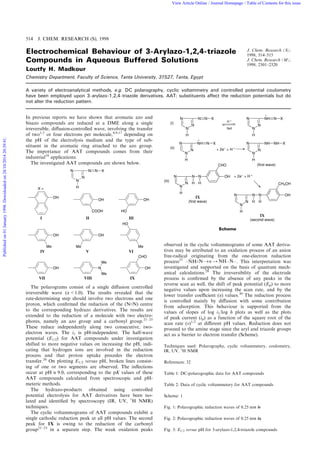
a1998b
- 1. Electrochemical Behaviour of 3-Arylazo-1,2,4-triazole Compounds in Aqueous Buffered Solutions Loutfy H. Madkour Chemistry Department, Faculty of Science, Tanta University, 31527, Tanta, Egypt A variety of electroanalytical methods, e.g. DC polarography, cyclic voltammetry and controlled potential coulometry have been employed upon 3-arylazo-1,2,4-triazole derivatives, AAT; substituents affect the reduction potentials but do not alter the reduction pattern. In previous reports we have shown that aromatic azo and bisazo compounds are reduced at a DME along a single irreversible, di€usion-controlled wave, involving the transfer of two1,3 or four electrons per molecule,4,9,17 depending on the pH of the electrolysis medium and the type of sub- stituent in the aromatic ring attached to the azo group. The importance of AAT compounds comes from their industrial18 applications. The investigated AAT compounds are shown below. The polarograms consist of a single di€usion controlled irreversible wave (a<1.0). The results revealed that the rate-determining step should involve two electrons and one proton, which con®rmed the reduction of the (N.N) centre to the corresponding hydrazo derivatives. The results are extended to the reduction of a molecule with two electro- phores, namely an azo group and a carbonyl group.21±23 These reduce independently along two consecutive, two- electron waves. The i1 is pH-independent. The half-wave potential (E1/2) for AAT compounds under investigation shifted to more negative values on increasing the pH, indi- cating that hydrogen ions are involved in the reduction process and that proton uptake precedes the electron transfer.26 On plotting E1/2 versus pH, broken lines consist- ing of one or two segments are observed. The in¯ections occur at pHI9.0, corresponding to the pK values of these AAT compounds calculated from spectroscopic and pH- meteric methods. The hydrazo-products obtained using controlled potential electrolysis for AAT derivatives have been iso- lated and identi®ed by spectroscopy (IR, UV, 1 H NMR) techniques. The cyclic voltammograms of AAT compounds exhibit a single cathodic reduction peak at all pH values. The second peak for 1X is owing to the reduction of the carbonyl group21±23 in a separate step. The weak oxidation peaks observed in the cyclic voltammograms of some AAT deriva- tives may be attributed to an oxidation process of an anion free-radical originating from the one-electron reduction process27 ±N ‡ H.N±‡e 4 NH±N X ±. This interpretation was investigated and supported on the basis of quantum mech- anical calculations.28 The irreversibility of the electrode process is con®rmed by the absence of any peaks in the reverse scan as well, the shift of peak potential (Ep) to more negative values upon increasing the scan rate, and by the lower transfer coecient (a) values.30 The reduction process is controlled mainly by di€usion with some contribution from adsorption. This behaviour is supported from the values of slopes of log i1/log h plots as well as the plots of peak current (ip) as a function of the square root of the scan rate (#)1/2 at di€erent pH values. Reduction does not proceed to the amine stage since the aryl and triazole groups act as a barrier to electron transfer (Scheme). Techniques used: Polarography, cyclic voltammetery, coulometry, IR, UV, 1 H NMR References: 32 Table 1: DC-polarographic data for AAT compounds Table 2: Data of cyclic voltammetery for AAT compounds Scheme: 1 Fig. 1: Polarographic reduction waves of 0.25 mM iv Fig. 2: Polarographic reduction waves of 0.25 mM ix Fig. 3: E1/2 versus pH for 3-arylazo-1,2,4-triazole compounds J. Chem. Research (S), 1998, 514±515 J. Chem. Research (M), 1998, 2301±2320 Scheme 514 J. CHEM. RESEARCH (S), 1998 Publishedon01January1998.Downloadedon28/10/201420:39:41. View Article Online / Journal Homepage / Table of Contents for this issue
- 2. Fig. 4: Cyclic voltammograms of 0.25 mM i at di€erent scan rates in aqueous-bu€ered solution of pH 9.2 Fig. 5: Cyclic voltammograms of 0.25 mM ix at di€erent scan rates in aqueous-bu€ered solution of pH 7.0 Fig. 6: Cyclic voltammograms of 0.25 mM ix at di€erent scan rates in aqueous-bu€ered solution of pH 11.1 Received, 19th January 1998; Accepted, 27th May 1998 Paper E/8/00519B References cited in this synopsis 1 W. U. Malik and R. N. Dua, J. Electroanal. Chem., 1982, 132, 211. 3 C. K. Seth, N. R. Bannerjee and V. K. Sharam, Electrochim. Acta, 1981, 26, 1915. 4 L. I. Dela Cruz Yaguez, I. M. Pingarron Carrazon and L. M. Pol Diez, Electrochim. Acta, 1986, 31, 119. 9 H. M. Killa, E. M. Mabrouk, A. A. Abd El-Fattah and S. A. Yasen, Anal. Lett., 1991, 24, 275. 17 R. N. Goyal and A. Kumary, Bull. Chem. Soc. Fr., 1987, 4, 577. 18 L. H. Madkour, M. A. Elmorsi and M. M. Ghoneim, J. Monatsh. Chem., 1995, 126, 1087. 21 G. Hornyl, Electrochim. Acta, 1986, 31, 1095. 22 J. M. Rodriguez-Mellado and J. J. Ruiz, J. Electroanal. Chem., 1986, 199, 177. 23 E. M. Mabrouk, H. M. Killa, A. A. Abd El-Fattah and S. A. Yasen, Collect. Czech. Chem. Commun., 1992, 27, 268. 26 P. Zuman, The Elucidation of Organic Electrode Processes, Academic Press, 1969, p. 115. 27 A. Sivakumara, S. Reddy and V. Krishnan, Indian J. Chem., Sect. A, 1983, 22, 800. 28 E. Hammam, J. Electroanal. Chem., in the press. 30 R. S. Nicholson and I. Shain, J. Anal. Chem., 1964, 36, 706. J. CHEM. RESEARCH (S), 1998 515 Publishedon01January1998.Downloadedon28/10/201420:39:41. View Article Online
